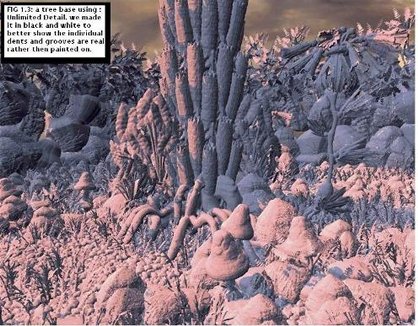The end of polygons: Can we have perfect graphics NOW?
Unlimited Detail claims they can offer "infinite geometry" on current hardware - the pinnacle of game engines
3D gamesare renderedwith polygons -little shapes that form surfaces. You know this. UNLEARN EVERYTHING YOU KNOW!Or... maybe not.
Startup Unlimited Detailhas instigateda minor internet brouhaha with a video which claims that they can do away with the imperfect polygonal approach andrender scenes whichcontain an unlimited number ofvoxels(like a pixel, butin 3D space)by using asuper-clever search algorithm which onlyprocesseswhat's visible to the player. And they sort of can.Sounds like brilliant, cutting-edge stuff, right? Check out their pitch below:
Aside from the logo they probably asked a first-year art student to design for free, it all looks pretty exceptional… until you consider things like, say, animation. Thanks to the brilliant folks of Reddit, which is, in fact, our most credible source in this case,and which is where we first encountered the video, we got knowledge’d hard.
Polygons are excellent for animations -you can stick a skeleton in them, apply physics to them, warp them however you like, and it’s all dandy. The “point clouds” described in the video, however, are best suited for rendering static scenes. Right, so... that’s not quite as exciting.

Above: It don't move
And while the voice over suggests that this technology has been held back by frightened executives, Unlimited Detail isn't actuallythe only one on the case. Reddit commentermindbleachhasexplained the current situationmuch better than we ever could:
3D gamesare renderedwith polygons -little shapes that form surfaces. You know this. UNLEARN EVERYTHING YOU KNOW!Or... maybe not. Startup Unlimited Detailhas instigateda minor internet brouhaha with a video which claims that they can do away with the imperfect polygonal approach andrender scenes whichcontain an unlimited number ofvoxels(like a pixel, butin 3D space)by using asuper-clever search algorithm which onlyprocesseswhat's visible to the player. And they sort of can.Sounds like brilliant, cutting-edge stuff, right? Check out their pitch below: Aside from the logo they probably asked a first-year art student to design for free, it all looks pretty exceptional%26hellip; until you consider things like, say, animation. Thanks to the brilliant folks of Reddit, which is, in fact, our most credible source in this case,and which is where we first encountered the video, we got knowledge%26rsquo;d hard. Polygons are excellent for animations -you can stick a skeleton in them, apply physics to them, warp them however you like, and it%26rsquo;s all dandy. The %26ldquo;point clouds%26rdquo; described in the video, however, are best suited for rendering static scenes. Right, so... that%26rsquo;s not quite as exciting. Above: It don't move And while the voice over suggests that this technology has been held back by frightened executives, Unlimited Detail isn't actuallythe only one on the case. Reddit commentermindbleachhasexplained the current situationmuch better than we ever could: %26ldquo;Ahh, sparse voxel octrees. Carmack intends to use them in the id Tech 6 engine (post-Rage). Here's what the video didn't mention: you can't animate these. They are as utterly inflexible as sprites. The closest you can come is to define every frame, can still have amazing object detail, but can't be procedurally animated (e.g. by ragdoll physics) and will move at a fixed framerate with no obvious tweening method. You can have this voxel world and it will look awesome, but it will be almost completely static%26hellip; %26hellip;I like the technology presented, but the presentation itself is vapid and disingenuous. This is not a cure-all. Even Carmack is only using it in conjunction with polygonal actors.%26rdquo; So this company is pulling our legs to some extent, but that doesn%26rsquo;t mean there%26rsquo;s nothing to be excited about. What they%26rsquo;re doing is cool, and, as mentioned by mindbleach,John Carmack is exploring ray-tracing techniquesfor his next generation graphics engine, and so are many other brilliant bastards, presumably. The three primary lessons we've learned are: A lot of people on the internet are a lot smarter than us. Videogames are going to continue blowing the crap out of our brains, and we have loads to look forward to... ...But don't betoo easily wooed by snarky YouTube pitches. "Unlimited Detail" is some impressive stuff, but it isn't a perfect solution by far. If you crave more knowledge, read theinformative Reddit thread. Mar 10, 2010
“Ahh, sparse voxel octrees. Carmack intends to use them in the id Tech 6 engine (post-Rage). Here's what the video didn't mention: you can't animate these. They are as utterly inflexible as sprites. The closest you can come is to define every frame, can still have amazing object detail, but can't be procedurally animated (e.g. by ragdoll physics) and will move at a fixed framerate with no obvious tweening method. You can have this voxel world and it will look awesome, but it will be almost completely static…
Weekly digests, tales from the communities you love, and more
…I like the technology presented, but the presentation itself is vapid and disingenuous. This is not a cure-all. Even Carmack is only using it in conjunction with polygonal actors.”
So this company is pulling our legs to some extent, but that doesn’t mean there’s nothing to be excited about. What they’re doing is cool, and, as mentioned by mindbleach,John Carmack is exploring ray-tracing techniquesfor his next generation graphics engine, and so are many other brilliant bastards, presumably.
The three primary lessons we've learned are:
- A lot of people on the internet are a lot smarter than us.
- Videogames are going to continue blowing the crap out of our brains, and we have loads to look forward to...
- ...But don't betoo easily wooed by snarky YouTube pitches. "Unlimited Detail" is some impressive stuff, but it isn't a perfect solution by far.
If you crave more knowledge, read theinformative Reddit thread.
Mar 10, 2010



